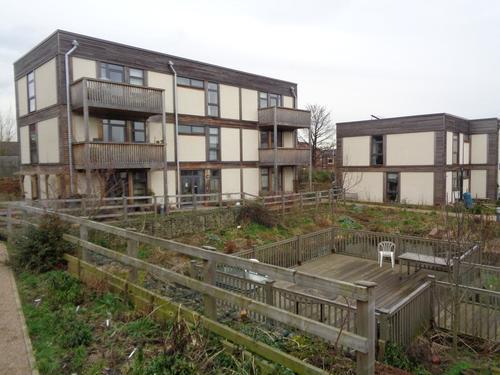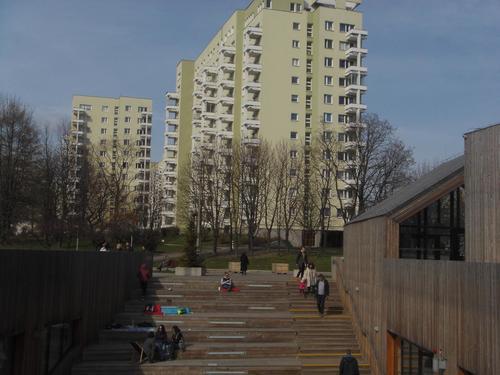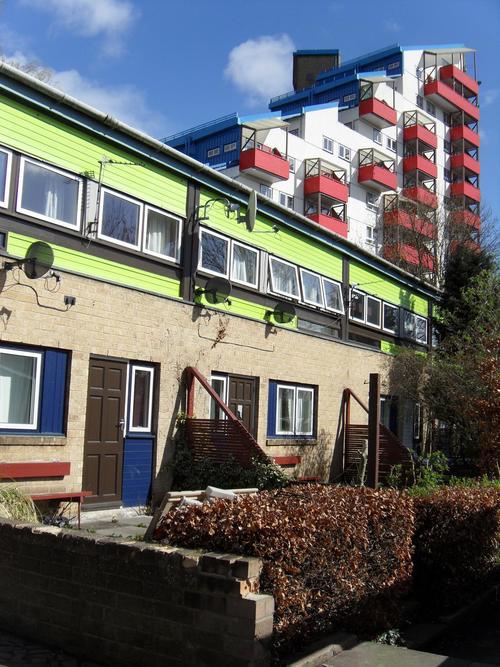Labour's 2017 manifesto was timid on housing but, globally, there are examples that could form the beginnings of a 21st century housing programme
The most puzzling aspect of the 2017 Labour Manifesto was its timidity on what is in much of the country the most important of all issues – housing. To be sure, it sustained the break with New Labour’s relentlessly market-driven housing policies already made under Ed Miliband, providing strong support for halting the alarming rise in homelessness, for rent controls, landlord licensing and council house building; and the promised use of a National Transformation Fund to build these homes is novel and promising.
Even so, given the scale of the housing crisis, and the strong appetite for decisive change, it was surprising in its mildness and in places, its conservatism. The pernicious notion of the ‘housing ladder’ is maintained, with the promise to ‘back First-Time Buyers to buy that special first home’. The terminological vagueness that will be familiar to those who follow the antics of the more right-wing Labour councils is continued when the flagship ‘million homes’ turn out to include ‘at least 100,000 council and Housing Association homes for genuinely affordable rent or sale’, with no indication of what a ‘genuinely affordable’ rent (let alone sale) actually is. A subsequent green paper was if anything even more timid. So what follows is a series of tentative suggestions of what can be done beyond this, with examples, where applicable, of where it works in practice in the present day.
Ownership: The Right To Not Have to Buy
In larger cities, where council housing can become extremely lucrative when sold on, and where discounts are still in place that provide enormous and unjust incentives, the Right to Buy has decimated council housing. A Labour government ought to follow the lead of the Scottish Parliament and the Welsh Assembly and abolish the Right to Buy outright. Council housing is too important and too badly needed to be used as a speculative instrument. Councils ought to be permissive to the wishes of residents – invocations of mandatory single-colour doors and bans on interior renovations are anachronistic – but residents ought to be able to feel that they live in a home, not an asset or a potential investment vehicle. Similarly, measures should be taken to ban outright the practice of Buy-to-Let, which has left entire new districts of London almost empty.
Far too much of the Manifesto concentrates on ownership, in a scenario where sharply increasing numbers, and the overwhelming majority of the young, are renters. Rather than trying to send them up a mythical hierarchical ladder, we need to concentrate on tenants’ rights. The government should introduce private tenancies that are genuinely secure, following models such as the Belgian ‘3-6-9’ system, whereby the standard tenancy is nine years, where there are major financial penalties for evicting tenants, and where rents can only be increased after three years. In terms of rent control, Labour ought to avoid the New York system, which favours those who have lived in an area long-term, but provides no security for newcomers and migrants – tempting as that model may well be to certain elements on Labour’s right wing. More attractive options include the system of ‘fair rents’ that was enforced in Britain until 1980, where the condition of the accommodation was a decisive factor for the setting of rent (given how some of the most expensive British property is in dilapidated Victorian stock, this could lead to drastic reductions); or, as the IPPR has recommended, a modified version of the German system of ‘rent brakes’. Both should avoid these discriminatory effects.

Given that we fully intend to burst the property bubble that dominates much of Britain’s economy, we will likely find that fewer people want to be landlords, as being one will no longer be, as it is now, a licence to print money for those with wealth. We should advocate what Danny Dorling has called ‘the right to sell’, whereby the government will buy back housing sold under the old Right to Buy, and will buy market housing (where it meets Decent Homes standards) and put it in the public sector, much as local authorities such as Camden and Glasgow did in the 1970s. John Healey’s suggestions that land will be bought at a nominal rather than speculative rate provide an outline of how that could work.
The important thing about council housing, which most other forms of housing short of outright ownership lack, is security. With increasing insecurity of the labour market and the spread of precarity, that security – secure tenancies, low rents, the knowledge that you do not have to pay off a mortgage or, worse, sustain a landlord who is living off you – is actually much more needed now than it ever was in the era of mass council housing and full employment. Accordingly, in terms of terminology, we need to avoid the meaningless term ‘affordable housing’, and make clear that a Labour government will only subsidise council housing, built by councils and let at a social rent, Housing Associations and co-operative housing, where the actors will be different but the same rules on social rent should apply.
Procurement and Construction: Building Housing Outside of a Sclerotic Market
One of the most important, but most opaque and confusing aspects of housing and construction in general is procurement, the process by which a planning application becomes an actual building or housing estate. In Britain, this process is labyrinthine, riddled with dozens of contractors and sub-contractors, arcane levels of bureaucracy and, not coincidentally, the poorest construction standards in western Europe, noticeable at every level from the tacky surfaces of new buildings to the disastrous cost-cutting that caused the Grenfell Tower fire. Under the current system, Labour could easily build its million new houses and yet these methods would make them ugly and naff at best, deeply unsafe at worst.
The first step to reforming this has already been made, in the policy that the Private Finance Initiative will be abolished and its contracts taken back in-house, a policy which is already showing positive results in Preston. However, the problem expands out beyond PFI, to an endemic and legally mandated insistence on cost-cutting, through Compulsory Tendering, where the lowest bidder always wins, to the notions of ‘Best Value’ and ‘value engineering’, where anything non-essential to the building is pared back by the contractors, leaving so much newly constructed housing as a caricature of its original ideas. These frameworks are a false economy, as the millions that will need to be spent to remove flammable cladding installed by New Labour’s regeneration programmes should make very clear. They need to be abolished, in favour of the simpler, stricter contracting systems used by countries like Switzerland, where social housing maintains standards well above the norm for British ‘luxury flats’.

Any radical housing policy is likely to encounter at least some opposition from the construction industry, which has long maintained blacklists against trade unionists despite, hand in hand with speculative investors, relentlessly driving down quality. John McDonnell and Unite have both suggested a new generation of Direct Labour Organisations – the local authority-owned construction companies which built many of our housing estates, libraries and schools in the 20th century. These would build in-house, circumventing the market as much as possible. Historically, however, DLOs have often been conservative in terms of construction, preferring ‘traditional’ methods which are often expensive. To counter the risk of this tendency, the government ought to look at scaling up the small-scale experiments made in low-energy and zero-carbon construction made by the likes of the LILAC community housing group in Leeds or We Can Make in Knowle, Bristol, as possible exemplars for methods of creating housing which are both sustainable and social. The expansion of employment and training that would result from this could be an integral part of a ‘Green New Deal’.
Renovation and Renewal, not ‘Regeneration’
New Labour’s policies on the regeneration of housing estates and depressed areas had one thing going for them – a massive quantity of investment going into places that had very little in the way of care or attention after their construction, and which have not seen much since 2010. These homes needed renovation, insulation and properly maintained public spaces, and some lucky housing estates got just that, with relatively mild strings attached. Beyond that, the flaws were manifest – the typical ‘carrot and stick’ approach of bribing working class people to achieve the desired outcomes, in this case through withholding money unless tenants voted to transfer their homes from local authorities to Housing Associations or ‘Arms Length Management Organisations’ (it is worth noting that the largest of these is in the Royal Borough of Kensington and Chelsea, and presided over the ‘renovation’ of Grenfell). On top of that, a huge amount of the renovation work on existing housing estates was breathtakingly poor, as, again, is obvious from the work currently being done to remove flammable cladding from the facade of (usually formerly) council-owned towers.
Similarly, much of the renovation work was driven by the paranoid agenda of ‘Secured by Design’, where essentially the police got to redesign housing estates to their tastes, with spiked fences around every bit of green and CCTV cameras everywhere. And in many cases – some of them, as in the Elephant and Castle, still ongoing – ‘regeneration’ has resembled James Baldwin’s description of 1960s American ‘urban renewal’ – ‘negro removal’. Estates have been needlessly broken up and in a notably inhuman metaphor ‘decanted’ to make way for new private housing in order, sometimes, to ‘cross-fund’ new council housing elsewhere, a telling example of the Faustian pacts that so many councils have congratulated themselves on signing.
There are many alternative models of housing renewal which could be looked at instead of this deeply contentious legacy. Countries in Central and Eastern Europe like Poland and the Czech Republic – by no means sympathetic to any kind of socialism – have renovated and insulated their concrete-panel housing simply, unpretentiously and attractively, with housing estates such as Warsaw’s Ursynów or Prague’s Jižní Mesto going from being considered shameful totalitarian blots on the landscape to green, attractive and colourful communities. There is no reason the same could not be done for technologically similar places like the Ledbury Estate in London or Pendelton in Salford; in fact, the model could be extended into the insulation of our enormous quantity of draughty and energy-inefficient Victorian stock.

A more radical model still is in schemes that both renovate and de-commodify. Recent examples include the renovation of the Seewon Sangga development in Seoul, which in its mix of housing, industry, markets and self-proclaimed ‘regeneration without gentrification’’, presents a model of redevelopment far more intelligent than anything we have dared in the UK. Similarly unusual is the renovation of the Tour Bois-le-Prêtre in Paris by the architects Lacaton and Vassal, which took a 1960s tower, slated to be demolished, and renovated it for the existing residents, giving them new winter gardens and adding wings of new social housing to the existing structure with no evictions and no changes in ownership. Notably, both of these were proven to be far cheaper than demolition and building anew, and neither has been precious about making major changes to the existing building fabric. There is no logical social, environmental or economic rationale for destroying places like the Aylesbury estate, let alone such intimate, low-rise communities as London’s Cressingham Gardens and Central Hill. A radical Labour manifesto ought to be absolutely clear that there should be no demolition of council or social housing unless it can be proven to be structurally unsound; no problem is so big that it can’t be solved while maintaining the existing buildings and the existing community.
Let a Hundred Flowers Bloom: Architecture and Design
Britain’s built environment is too often cheap, nasty and kitsch, and housing is often worst of all. One of New Labour’s better ideas was the setting up of the Commission for Architecture and the Built Environment (CABE) to maintain and monitor the quality of new developments. It is unsurprising that it was wound up by the coalition government, and now exists merely as a private, ineffectual charity. But it had its drawbacks – namely, a ‘jobs for the boys’ tendency, with architects (and developers such as Stuart Lipton) praising and waving through the work of their mates, and with a purely advisory and reactive role, which in practice meant trying to stop the worst from happening rather than planning for the best. A revived CABE which is more democratic and open to those not part of the architectural elite ought to go alongside the return of city and borough architects departments employed by our local authorities. This would not be created out of thin air, but is something for which there is a groundswell at the moment, in the work of institutions like Public Practice, who are trying to create a new generation of municipal planners and architects. Current models such as the widely praised role of Bouwmeester, employed by most cities in Flanders, provide a useful hint of what this would be like in practice, and the virtues of having planners and architects who live and work continuously in the same city, rather than as floating multinational consultants.
In terms of architectural style, anything officially mandated would be foolish, whether the jolly modernism insisted upon by the Urban Task Force in the Blair years, the classicism lobbied for by sundry royals and Tories, or the dour, currently dominant ‘vernacular’ of brick-clad concrete grids. However, the latter emerged out of the recent London Design Guide, which had at least the virtue of setting decent minimum standards for room sizes, balconies and so forth. These measures should be continued and radicalised, so that rather than simply mandating a tweedy and pompous aesthetic, they make legally mandatory decent standards for all new housing. This should be reinforced by making legally mandatory the Building Research Establishment Environmental Assessment Method’s ‘Outstanding’ standard for sustainable construction in any development that is receiving public funding.

Who is Mixing Who? - Social Planning, not Social Cleansing
The model of mass council housing has often been criticised for being monolithic and homogenising. Although it has virtues in terms of security, de-commodification and of stopping people from having to worry about their housing that no other model has yet matched, this critique has some salience, especially in terms of the more peripheral and suburban housing estates. Anywhere that is all the same, whether all council or all private, all asphalt or all greenery, all Modernist or all Victorian, is liable to feel bleak and limiting. However, we should regard making council housing an option for the middle class (who, in inner London at any rate, already frequently rent ex-council stock, and at well above social rent) rather than ‘pepper-potting’ private and public- as if public housing was something to be ashamed of- as the best way of achieving a multifaceted social space.
Without making the grand claims for them that some on the activist left have occasionally indulged in, we should encourage co-operative, communal forms of housing ownership, and, as mentioned, alternative models of construction. This should be within a framework of municipal and regulated housing, given that most people do not want to build their own homes, however much libertarians might insist that they do; but where they emerge, models that aim at communal ownership should be aided and subsidised. A variety of them now exist and thrive in the UK, from Homes for Change in Manchester to LILAC in Leeds, and their social spaces and public areas are usually far superior to the wan fare of much current ‘social’ housing. The ‘Baugruppen’ of Berlin, similarly, show a way of building and living communally that moves beyond lifestyle experiments and cliques.

Any new state-driven development should be a mix of council, co-operative and communal housing, and within that the Community Land Trust model may be useful, provided that there is abundant provision also for those that do not have the time or inclination to personally manage their housing. The usefulness of Housing Associations is more unclear. They emerged out of charity, rather than democracy, and they have often been a cudgel to beat council housing with; their CEOs are paid outrageous salaries and since 2010, they have increasingly become little more than property developers. However, they now own the majority of social housing in Britain, so legislation would need to be brought in to make sure they function effectively as democratic organisations providing non-market housing, rather than being, as they are so often now, charitable fig-leaves for gentrification.
Housing Associations and councils both should be held accountable by mandatory, democratic tenants’ associations; in fact, the model of the tenants association should be expanded out from the public sector into the private, with ‘renters unions’ having similar rights of negotiation and representation to unions in the workplace.
The above is not intended to be at all definitive, but as a point where discussion can begin about what a socialist housing policy in Britain in 2018 might look like. Certain subjects, like homelessness, housing for the elderly, and the place of housing within the wider notion of a democratic and socialist city are not touched upon. But given that each one of the examples above exists, now, in a capitalist country, we have the right to regard this as a fairly modest place to start.
